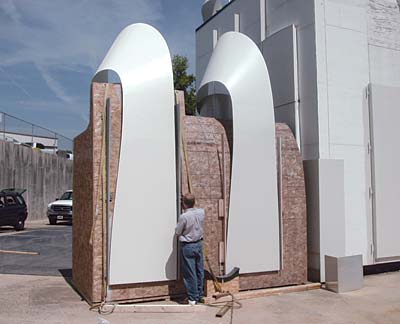Rain-Screen Facades Are More Than Skin Deep
The diversity of components and the number of construction trades involved sometimes presents a challenge for rain-screen projects like the High expansion. At the High, three primary subcontractors were responsible for the building envelope-one for the stud backup wall, another for the steel fins and their attachment to that backup wall, and a third for the aluminum panels and their frame-complicating coordination of stud locations and the rain-screen structure. "The facade works as a system but is delivered as separate parts," says McClelland.
The choice of a rain screen also had construction advantages, points out John Starr, AIA, Lord Aeck Sargent partner in charge of the High project. Because the architectural envelope is divorced from the weather barrier, quick erection of the building's enclosure is possible, he says. Rain screens are particularly well suited for a museum because it is a building type with a high percentage of solid wall and few windows. "The basic box can go up and be weatherproofed quickly," he says.
In contrast to the High, a planned sciences research facility for Brandeis University, near Boston, has large expanses of glazing. The south facade of the 200,000-square-foot building, planned for completion in 2011, will be almost entirely glass curtain wall with sun-shading devices. But Payette plans to clad other areas with open-jointed, fiber-reinforced cement panels. Although one material is transparent and the other opaque, both are part of a strategy to detail the building as a series of layers, says Kevin Sullivan, AIA, principal in charge of the project. "Expressing these materials as components hung [from the building] was appealing from an aesthetic point of view," says Sullivan.
 |
| The High's designers built a mock-up of the skylight sunshade to identify any weaknesses inherent in the sail-like shape. Photography: Courtesy Arup |
The panels will be mounted on aluminum furring channels and anchored to a backup stud wall. Although there will be an approximately 3-inch gap between the panels and the rubberized asphalt membrane that serves as an air and vapor barrier, the assembly is not compartmentalized and not designed to achieve pressure equalization, according to Michael Louis, principal of SGH, the project's facade consultant.
The Brandeis project's panels will dissipate some of the kinetic energy of wind-driven rain. However, the real defense against water penetration will be the membrane adhered to the stud-wall sheathing, says Louis. The project is now in design development, and SGH is detailing window penetrations and connection points between the panel assembly and the glazed curtain wall to make sure the air and vapor barrier is continuous, and properly detailed flashing is provided.
Flashing can be the Achilles heel of an otherwise well executed exterior wall system, according to Schwartz, Louis's colleague at SGH. He stresses the importance of careful detailing, correct material selection, and proper installation. Schwartz recommends, for example, that through-wall flashing extend beyond the building face, and points to the unfortunate but common practice of specifying flashing material with only a 5 to 10 year life span in an assembly expected to last half a century. "It is critical that the expected service life of the flashing match that of the rest of the building," he says.








